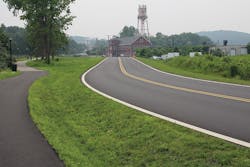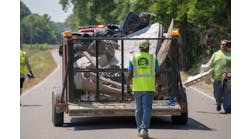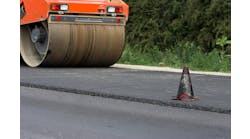In April of this year, county and local officials joined residents of Wharton Borough, New Jersey for a ribbon-cutting ceremony to mark the official opening of a 1,100-ft extension of Wharton’s North Main Street. The extension was dubbed “Chegwidden Way” in honor of the first person to drive on it, longtime Wharton Borough Mayor William “Bill” Chegwidden.
The Chegwiddens have made Wharton their home for six generations. The town is nestled in the heart of Morris County, which routinely ranks high on lists of the best places to raise a family in New Jersey—and the U.S. The borough of Wharton is known for attractions that include Hugh Force Canal Park, featuring scenic hiking trails along the former Morris Canal and abandoned railroad beds. Wharton is also home to a number of warehouses and fulfillment centers, mostly situated in the southern end of the borough, which drive a robust regional economy.
Like any bustling community, Wharton had a trouble spot—a congested and historically problematic intersection. Mayor Chegwidden, who has served both the borough and surrounding Morris County for decades as a borough councilman, mayor, and county commissioner, was determined to get an extension built to address this issue.
According to Morris County officials, this new route is only the second one built in the county in the past 50 years. But given the impact it will have on the health and safety of area motorists and residents, it may well be one of the most important. Chegwidden Way may have taken years and considerable resources to build, but that time and effort will help prevent many vehicle-related accidents and damages to property.
A Troublesome intersection
Work on the extension began about a year ago. But Mayor Chegwidden and key Morris County and borough leaders had been working diligently since 2001 to obtain necessary permits and raise funding for the project. The delays were caused by environmental issues, as well as other complications and challenges associated with the construction area. It required tireless efforts by borough and county officials, and several private companies, to negotiate the complex permitting process, obtain the required funding, and create and implement the construction plan that finally made Chegwidden Way a reality.
Wharton Borough has more than 20 miles of roadway running through it. The main highways serving the borough are I-80, which travels east-west, and New Jersey Route 15, running north-south. For many years, motorists and truckers traveling to and from I-80 and Route 15 from the southern and central parts of the borough had to brave an occasionally perilous intersection at North Main Street and East Dewey Avenue.
As previously noted, Wharton Borough’s southern end is dominated by warehouses and distribution centers. Numerous shipping trucks competed with motorists for a crowded strip of roadway that lacked the capacity for such heavy traffic. The hazards from traffic congestion were exacerbated by the intersection’s poor configuration, which forced very difficult turns on any vehicles driving though that strip of roadway.
The results were predictable. For many years, there was a high rate of vehicular accidents along the intersection of North Main Street and East Dewey Avenue. Many of these accidents involved trucks, tractor trailers, and fixed objects such as utility poles and street signs. An engineering report commissioned by borough officials and conducted by T&M Associates, the firm responsible for the design and construction report of Chegwidden Way, found that crashes involving trucks and fixed objects along this intersection were twice the statewide average.
For Mayor Chegwidden and county leadership, the situation was unacceptable, and the solution appeared obvious: create a bypass, or extension route, leading away from the troubled intersection for vehicles navigating to and from I-80 and Route 15. The extension that would eventually be known as Chegwidden Way would be a two-way lane about 1,100 ft long and 30 ft wide, and would connect North Main Street at a point just south of the troubled intersection to another part of East Dewey Avenue. By providing this North Main Street extension, a large percentage of trucks and other vehicles could be diverted toward I-80 Eastbound. This would have the effect of untangling traffic, reducing accidents, and making the roadways safer for pedestrians.
Construction Site Complications
But implementing this solution would be far from a simple, straightforward process. Constructing the extension required complying with New Jersey Department of Environmental Protection (NJDEP) regulations. The area of construction lays along a floodplain—a piece of low-lying ground adjacent to a river, formed mainly of river sediments and easily subjected to flooding from storm-water overflows—between Washington Pond and the Rockaway River. To construct the extension would involve filling a series of man-made ditches from earlier projects. Under NJDEP regulations, depressions in floodplain areas are not supposed to be filled in as this would risk expanding potential flooding into other areas. Any other construction activities would also have to involve minimal impact on floodplain effects and storm-water management.
Such challenges would already have been daunting during a normal year—but it is worth noting that the design and construction took place at the height of the COVID-19 pandemic, with numerous protocols put in place to keep workers and other stakeholders safe and healthy, while still keeping essential construction services moving forward.
There were additional complications. Property along the extension was owned privately, and Wharton Borough would have to negotiate with those owners before beginning the project. Much of the soil in the area was of poor quality because of wetland conditions and the presence of a former industrial site. The proposed extension would require the demolition of an unused warehouse building. It would also involve the removal of the warehouse’s parking lot pavement, other unused paved sites, and the removal and realignment of an existing paved path used by both pedestrians and bike riders. Finally, there was the overall cost of the project, which would be well over $1 million.
Given all these complications, a number of alternatives were considered. But some options would not have adequately addressed traffic issues and would have had negative environmental impacts, while other alternatives would have required extensive right-of-way acquisition, property owner displacement, and routes that would be too circuitous.
Finally, the cost and complication of the proposed project prompted consideration for not building any new roadways at all. But the studies demonstrating the intersection often compromised the safety of pedestrians, students, passenger cars, and trucks pointed to a compelling need to find a solution to the problem.
A Series of solutions
A thorough review of the construction area enabled T&M Associates to propose a design for the extension that could overcome most of the project’s challenges. The use of three equalizer pipes would enable the extension to be constructed in compliance with NJDEP regulations. Equalizer pipes would provide equalization of water flow under and around the roadway, as well as a positive drainage course. This would prevent the trapping of storm water that could impact floodplain effects to surrounding areas.
The elevated design of the roadway surface would also allow for the smooth discharge of storm water into vegetated embankments and naturally vegetated woodland areas, further mitigating the floodplain dangers. Poor quality soil, which could also lead to increased flooding and roadway instability, would be supported by a geogrid, a flexible mesh used to create a reinforced coherent mass behind a retaining wall or substructure through soil stabilization.
The removal of the existing warehouse building and the removal and regrading of other paved areas within the construction area proved to be more than just logistical necessities for the project. Implementing these changes would also help mitigate floodplain effects, as they resulted in the creation of approximately 8,000 cubic ft of flood storage. The proposed extension design would also ensure any physical changes to the construction area due to remediated contaminated soil would be accounted for. These areas would be filled in and shaped to the new roadway, to minimize any negative storm-water effects.
The proposed design plan, completed in 2008, would preserve the integrity of the construction area’s floodplain and not require additional storm-water management resources, ensuring it would comply with NJDEP regulations. It would also vastly improve roadway health and safety conditions for motorists, truck drivers, and Wharton community residents.
A team effort
In 2009, NJDEP finally issued permits for work on the area floodplain and wetlands, about eight years after Mayor Chegwidden, other elected officials, and local stakeholders had begun searching in earnest for solutions to the troubled intersection. Further permits were obtained in 2014.
Other challenges had to be met, including accounting for nearby abandoned mine shafts and negotiating right-of-way with property owners along the proposed extension. Approximately $1.7 million in funding was secured from Morris County for the project. Private partners in the endeavor came to include Greenman Pedersen Inc. who handled inspections, and Tomco Construction, who handled the extension construction phase that finally began in March of 2020.
Fittingly, Mayor Chegwidden was the first person to drive on the extension at the ribbon cutting in April. He was joined in jubilant celebration by many other family members, as well as current and former elected officials and community members who were instrumental in getting the extension built. These included Morris County Commissioner Director Stephen H. Shaw; County Commissioner Deputy Director Deborah Smith; Commissioners Doug Cabana, John Krickus, and Tayfun Selen; and Wharton Councilman Vince Binkoski.
Mayor Chegwidden credited this accomplishment as a team effort.
“I’m honored that Chegwidden Way bears my name, but it really honors everyone who helped make this a reality,” he said. “This took many years of research, negotiation, advocacy, and fundraising. We want to thank all the elected officials, community members, stakeholders, and partners for their efforts and perseverance over the past two decades. Thanks to them, we’ve made Wharton and Morris County safer for our motorists, our businesses, and our community residents.”



